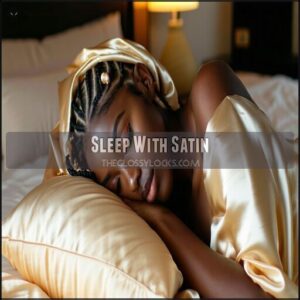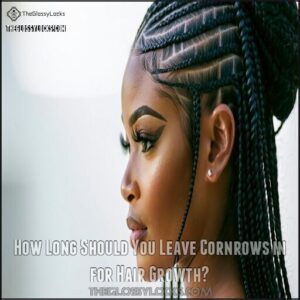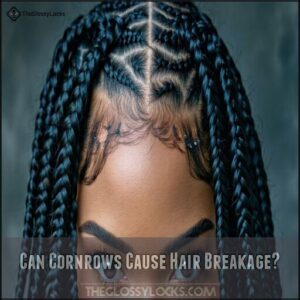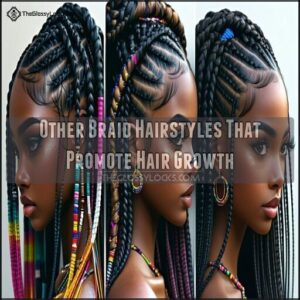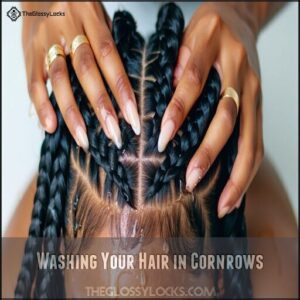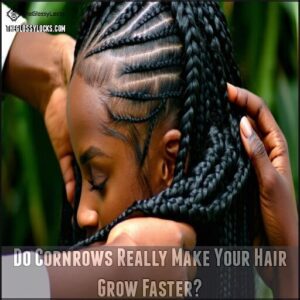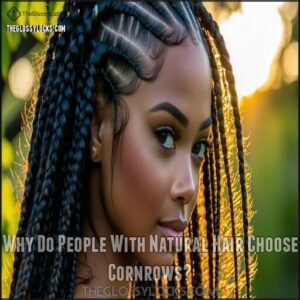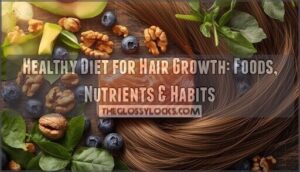This site is supported by our readers. We may earn a commission, at no cost to you, if you purchase through links.
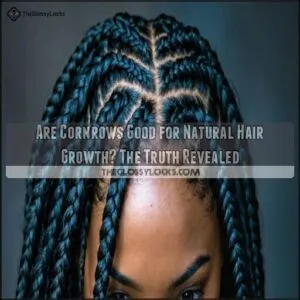
They’re a protective style, meaning they shield your hair from breakage and daily wear and tear.
By keeping your hair tucked away, cornrows help retain moisture and prevent split ends.
But here’s the catch: tight braiding can cause tension and even breakage, so always go for a gentle install.
Regular scalp care, like moisturizing and cleansing, is also key.
Think of cornrows as a cozy blanket for your strands—just don’t leave them in too long, or the benefits might unravel.
Curious about maintenance tips? Stay tuned for more!
Table Of Contents
- Key Takeaways
- What Are The Benefits of Cornrows?
- How Do You Care for Your Cornrows?
- What Are Cornrows and How Do They Work?
- How Long Should You Leave Cornrows in for Hair Growth?
- Can Cornrows Cause Hair Breakage?
- Other Braid Hairstyles That Promote Hair Growth
- Washing Your Hair in Cornrows
- Do Cornrows Really Make Your Hair Grow Faster?
- Why Do People With Natural Hair Choose Cornrows?
- Frequently Asked Questions (FAQs)
- Do cornrows make hair grow faster?
- How long should you keep cornrows in for hair growth?
- What are the disadvantages of cornrows?
- What hairstyle is best for hair growth?
- Are there any risks associated with cornrows?
- Are there any hairstyles that should be avoided if trying to grow natural hair?
- How can you prevent traction alopecia with cornrows?
- Are cornrows suitable for all hair textures?
- Do tight cornrows impact scalp health negatively?
- Should you avoid extensions for healthier cornrows?
- Conclusion
Key Takeaways
- Cornrows protect your hair by minimizing daily manipulation, retaining moisture, and reducing breakage.
- Don’t make them too tight, as excessive tension can cause hairline damage and traction alopecia.
- Regular scalp care, like moisturizing and gentle cleansing, keeps your cornrows fresh and promotes healthy growth.
- Avoid leaving cornrows in for more than 6–8 weeks to prevent buildup, matting, and potential hair damage.
What Are The Benefits of Cornrows?
You’ll find that cornrows protect your natural hair by minimizing daily manipulation and creating a barrier against environmental damage that often leads to breakage.
Cornrows shield your hair, reducing daily wear and tear while fostering an ideal environment for growth and moisture retention.
They also promote healthy hair growth by reducing tangles and friction while allowing you to maintain proper scalp moisture, basically giving your hair a stress-free environment to thrive.
Protective Style
Cornrows’ protective power lies in their ability to shield your natural hair from daily environmental stressors.
They prevent damage by minimizing manipulation and reducing exposure to harsh elements. When properly installed, cornrows distribute tension evenly across your scalp, helping maintain scalp health while protecting fragile ends.
This protective style excels at moisture retention, keeping natural oils where they belong—in your hair.
The styling versatility of cornrows lets you express yourself while simultaneously preventing breakage. For those seeking hair growth, cornrows create an ideal environment by reducing friction and mechanical damage that typically causes length loss.
Cornrows combine style and strength, reducing friction to protect hair while creating the perfect environment for healthy, natural growth.
Hair Growth Promotion
While protective styling shields your hair from damage, it’s what happens beneath those neat rows that truly powers your growth journey.
Cornrows create an ideal environment for natural hair growth through multiple mechanisms. They improve scalp stimulation as the even tension potentially increases blood flow to follicles.
Your growth cycle continues uninterrupted while your ends remain protected, reducing breakage that often masks true length gains. Without daily manipulation, your hair retains more moisture and better absorbs nutrient delivery from oils and treatments.
Proper hydration methods are easier to implement when your strands are neatly contained. You’re not forcing your hair to grow faster (that’s genetically determined), but you’re creating favorable conditions for retaining the growth you naturally achieve.
Think of cornrows as training wheels for your hair growth techniques.
How Do You Care for Your Cornrows?
Taking care of your cornrows keeps your hair healthy and helps them last longer.
Regular moisturizing, gentle cleaning, and nighttime protection are key to maintaining their look and promoting hair growth.
Proper Initial Installation
Now that you know the benefits, let’s look at how proper installation sets the foundation for healthy cornrows.
Starting with the right prep makes all the difference for your natural hair journey:
- Hydrate hair before styling with a thorough shampoo using sulfate-free products
- Skip blow-drying to prevent unnecessary heat damage
- Create an oil mixture to cleanse your scalp thoroughly
- Massage shampoo gently into your scalp to remove buildup
- Apply conditioner after washing for added moisture retention
Controlling hair tension during installation helps prevent traction alopecia. Your stylist should create precise partings and consistent braid patterns while maintaining scalp health throughout the process.
Refreshing Your Hair
To keep your cornrows looking fresh, wash them every 7-10 days with a gentle shampoo and conditioner.
This regular Scalp Refresh prevents Product Buildup that can hinder hair growth.
When washing, avoid hot water and rough handling, as these can cause frizz and breakage.
After cleansing, apply Revitalizing Oils like jojoba or argan to give your hair a Moisture Boost.
These cornrow benefits extend beyond appearance – they maintain scalp health, which is essential for natural hair growth.
Between washes, use a Braid Refresher spray to revitalize your style.
Consider using a specialized braid product for ideal results.
Simply mist your cornrows lightly, focusing on the scalp and braids themselves.
Remember to rinse thoroughly after washing to remove all residue, as leftover products can clog follicles and interfere with your hair growth tips.
Sleep With Satin
Your hair deserves royal treatment, even while you sleep.
Cover cornrows with a silk or satin bonnet nightly to minimize friction and preserve moisture. Alternatively, a satin pillowcase works wonders if bonnets feel uncomfortable.
Many prioritize a bonnet for sleep to protect their hair.
Before bedtime, lightly moisturize your braids, then let them flow freely under your protection. This nighttime routine prevents breakage, reduces frizz, and extends the life of your protective style.
What Are Cornrows and How Do They Work?
Cornrows are three-strand braids woven close to the scalp in continuous, raised rows using an underhand, upward braiding technique.
This traditional African hairstyle works by taking small sections of hair, dividing them into three strands, and adding hair from below into the middle strand as you braid.
When properly installed, cornrows:
- Protect your natural curls from environmental damage
- Keep moisture locked in, preventing breakage
- Provide a low-maintenance style that supports hair growth
The hair parting and pattern creation determine the final look, with endless design possibilities ranging from simple straight rows to complex geometric designs.
Cornrows work well for various hair types, especially tight-textured hair.
For ideal results, understand that hair type impacts durability.
How Long Should You Leave Cornrows in for Hair Growth?
Finding the ideal duration for keeping cornrows installed is vital for maximizing hair growth while preventing damage.
The ideal timeframe for wearing cornrows ranges from 2 to 8 weeks, depending on your individual hair type and maintenance routine. Finer hair textures may require removal around the 2-3 week mark, while coarser textures can safely extend to 6-8 weeks.
Key factors for your growth cycle:
- Watch for regrowth signs—when new growth exceeds half an inch, it’s time to take down your protective style
- Monitor for scalp buildup or frizz, which signal it’s time for a refresh
- Pay attention to any tension or discomfort, as this indicates potential damage
Remember that individual variation plays a significant role in how your hair responds. Many find that using scalp oils on cornrows helps to maintain moisture. Regardless of texture, never keep cornrows installed beyond 8 weeks, as this won’t accelerate growth but instead may lead to matting, breakage, and other issues that compromise your hair health goals.
Can Cornrows Cause Hair Breakage?
While leaving cornrows in for the right duration supports growth, understanding their potential to cause breakage is just as important.
Yes, cornrows can cause hair breakage, but it’s usually due to improper techniques rather than the style itself. Notably, harsh shampoos can lead to hair breakage.
Here’s what you need to watch for:
| Risk Factor | Prevention Strategy | Warning Signs | Action Required |
|---|---|---|---|
| Tension Breakage | Request looser installation | Scalp pain, bumps | Remove immediately |
| Hairline Thinning | Avoid edge strain | Receding hairline | Alternate styles |
| Prolonged Wear | Remove after 6 weeks | Matting, buildup | Deep condition after |
| Removal Damage | Use oil to soften | Excessive shedding | Gentle detangling |
Your hair’s response to cornrows depends on your installation impact and maintenance routine—not everyone experiences traction alopecia.
Other Braid Hairstyles That Promote Hair Growth
Protective styles like Box Braids, Crochet Braids, and Twist Styles are great braid alternatives for promoting hair growth.
These natural hairstyles reduce daily manipulation, helping to prevent breakage. Lightweight products, like natural oils or moisturizing sprays, keep your scalp healthy without weighing down strands.
Adding beads or accessories can also protect your braids while letting your personality shine. Remember, gentle installation and regular care are key.
With these protective hairstyles, you’re giving your hair a well-deserved break while encouraging stronger, healthier growth.
Washing Your Hair in Cornrows
Keeping your cornrows clean is simpler than you’d think.
Wash every 2–3 weeks to prevent product buildup and maintain a healthy scalp. Use a sulfate-free shampoo to cleanse gently, followed by a watered-down conditioner for hydration.
After rinsing, pat your braids dry with a microfiber towel to avoid frizz.
For added care:
- Massage your scalp during washing to boost blood flow.
- Avoid heavy products that clog pores.
- Keep your scalp moisturized with oils.
- Be consistent with your washing schedule for best results to achieve a clean and maintained look.
Do Cornrows Really Make Your Hair Grow Faster?
Cornrows don’t make your hair grow faster, but they’re great for protecting it.
Growth rate factors like genetics, scalp stimulation, and proper care matter more. Cornrow myths often suggest instant hair growth, but their real magic lies in reducing breakage and retaining length.
For ideal results:
- Massage your scalp gently to improve blood flow and support hair growth secrets.
- Moisturize regularly with oils like argan to keep your scalp hydrated.
- Avoid tight braids to prevent stress and damage to natural hair.
Why Do People With Natural Hair Choose Cornrows?
Cornrows are more than just a hairstyle—they’re a perfect blend of fashion, function, and history.
People with natural hair love them for their protective styling benefits, low maintenance needs, and style versatility.
They help prevent damage by reducing manipulation and retaining moisture, all while celebrating a deep cultural connection.
- Protect your strands: Cornrows shield hair from breakage and promote healthier growth.
- Embrace ease: Low-maintenance care frees up your routine.
- Stay stylish: Experiment with endless patterns and designs that express your personality.
Frequently Asked Questions (FAQs)
Do cornrows make hair grow faster?
Don’t put the cart before the horse—cornrows don’t make hair grow faster.
But they protect your strands by reducing breakage.
Healthy hair thrives in low-manipulation styles, so cornrows can support length retention over time.
How long should you keep cornrows in for hair growth?
You should keep cornrows in for 6-8 weeks to support hair growth.
Longer wear can cause tangling and breakage.
Moisturize regularly, clean your scalp weekly, and listen to your hair’s needs for the best results, focusing on regularly maintaining your hair’s health.
What are the disadvantages of cornrows?
Tight cornrows can feel like a blessing that turns into a burden.
They risk traction alopecia, scalp irritation, and breakage if too tight or left in too long.
Neglecting care invites dryness, buildup, and tangled roots.
What hairstyle is best for hair growth?
Hairstyles that protect your hair, like loose braids, twists, or buns, can help with growth by reducing breakage.
Avoid tight styles or excessive tension, keep it moisturized, and prioritize regular scalp care for the best results, which includes understanding the importance of moisturized hair.
Are there any risks associated with cornrows?
Every rose has its thorn, and cornrows are no exception.
If braided too tightly, they can cause traction alopecia, tension headaches, or hairline damage.
Long-term wear without care leads to matting, dryness, and breakage.
Are there any hairstyles that should be avoided if trying to grow natural hair?
Avoid hairstyles that pull your hair too tight, like high ponytails or buns, which can cause breakage.
Excessively tight braiding or styles requiring constant manipulation can stress your scalp and slow your hair growth journey, which is a critical aspect of maintaining healthy hair through avoiding breakage.
How can you prevent traction alopecia with cornrows?
To prevent traction alopecia, make sure your cornrows aren’t too tight, and give your scalp regular breaks between styles.
Moisturize your scalp, avoid excessive tension, and listen to your head—discomfort is your cue to stop, as it indicates potential harm to your scalp.
Are cornrows suitable for all hair textures?
Like a well-tailored outfit, cornrows work best when matched to your hair’s texture and strength.
They suit most hair types but require careful braiding and maintenance to prevent tension, breakage, or damage to finer strands, which is crucial for the overall health and appearance of your hair, making maintenance a key aspect.
Do tight cornrows impact scalp health negatively?
Tight cornrows can harm your scalp by causing tension, soreness, and even hair loss, like traction alopecia.
It’s like pulling on your roots too hard—they need some slack to stay healthy and happy, which is a key point to consider to avoid traction alopecia.
Should you avoid extensions for healthier cornrows?
Think of extensions like seasoning—use them sparingly.
They can add style, but long-term use might stress your scalp and strands.
For healthier cornrows, let your natural hair shine and reduce the weight on braids.
Conclusion
Think of cornrows as a strong foundation for natural hair growth, like sturdy roots anchoring a tree.
They can protect your strands, retain moisture, and minimize breakage—if you treat them right.
Always opt for gentle installation, maintain a clean, moisturized scalp, and avoid leaving them in too long.
Cornrows won’t magically make your hair grow faster, but with proper care, they can support healthy growth.
So, are cornrows good for natural hair growth? Absolutely—with mindful upkeep!




